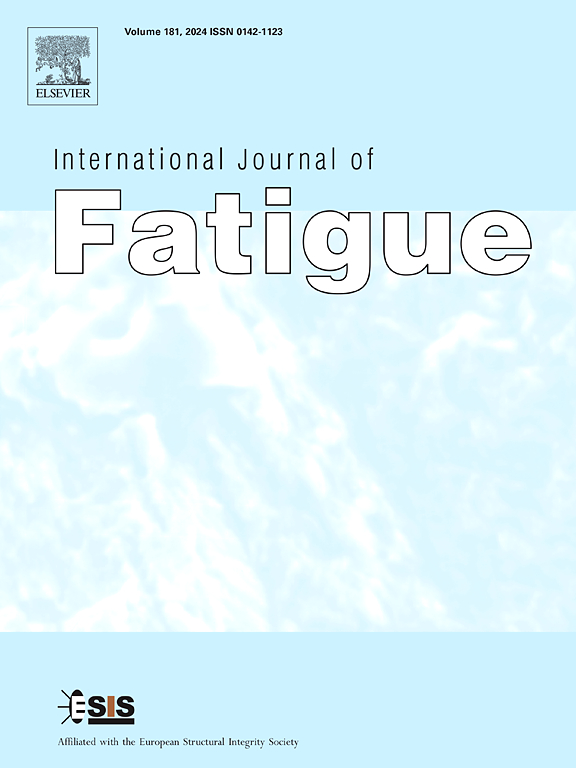滚动接触疲劳剥落失效的相场模型
IF 5.7
2区 材料科学
Q1 ENGINEERING, MECHANICAL
引用次数: 0
摘要
为研究滚动接触疲劳(RCF)载荷下的剥落行为,开发了一种将塑性和疲劳耦合的相场模型。利用基于能量最小化理论的相场模型,可以有效预测疲劳裂纹的成核、扩展和分叉。通过使用具有显式积分方案的有限元法,建立了一个数值框架。分析了地下引发的剥落、裂缝演变和 RCF 寿命。揭示了剥落模式、接触压力和剪应力的演变,以及断裂韧性和微空洞对 RCF 行为的影响。结果表明,断裂韧性越高的材料,其 RCF 寿命越长。此外,由于局部应力集中,高应力地下区域附近的微空洞会显著缩短材料的 RCF 寿命。这些结果可以帮助我们深入了解表层下剥落破坏的机理,为预测 RCF 性能提供可靠的数值框架。本文章由计算机程序翻译,如有差异,请以英文原文为准。
A phase field model for spalling failure due to rolling contact fatigue
A phase field model coupling plasticity and fatigue is developed to investigate spalling behavior under rolling contact fatigue (RCF) loading. Fatigue crack nucleation, propagation, and bifurcation can be effectively predicted using the phase field model based on theories of energy minimization. A numerical framework is established by using the finite element method with an explicit integration scheme. The subsurface initiated spalling, the crack evolution, and the RCF lifetime are analyzed. The spalling patterns and the evolution of contact pressure and shear stress are revealed, along with the influence of fracture toughness and the microvoids on RCF behavior. The results indicate that materials with higher fracture toughness yield longer RCF lifetime. Additionally, microvoids near the subsurface region of high stress significantly reduce the material’s RCF lifetime due to localized stress concentration. The results may provide insights into the mechanisms of subsurface spalling failure, offering a reliable numerical framework for predicting RCF performance.
求助全文
通过发布文献求助,成功后即可免费获取论文全文。
去求助
来源期刊

International Journal of Fatigue
工程技术-材料科学:综合
CiteScore
10.70
自引率
21.70%
发文量
619
审稿时长
58 days
期刊介绍:
Typical subjects discussed in International Journal of Fatigue address:
Novel fatigue testing and characterization methods (new kinds of fatigue tests, critical evaluation of existing methods, in situ measurement of fatigue degradation, non-contact field measurements)
Multiaxial fatigue and complex loading effects of materials and structures, exploring state-of-the-art concepts in degradation under cyclic loading
Fatigue in the very high cycle regime, including failure mode transitions from surface to subsurface, effects of surface treatment, processing, and loading conditions
Modeling (including degradation processes and related driving forces, multiscale/multi-resolution methods, computational hierarchical and concurrent methods for coupled component and material responses, novel methods for notch root analysis, fracture mechanics, damage mechanics, crack growth kinetics, life prediction and durability, and prediction of stochastic fatigue behavior reflecting microstructure and service conditions)
Models for early stages of fatigue crack formation and growth that explicitly consider microstructure and relevant materials science aspects
Understanding the influence or manufacturing and processing route on fatigue degradation, and embedding this understanding in more predictive schemes for mitigation and design against fatigue
Prognosis and damage state awareness (including sensors, monitoring, methodology, interactive control, accelerated methods, data interpretation)
Applications of technologies associated with fatigue and their implications for structural integrity and reliability. This includes issues related to design, operation and maintenance, i.e., life cycle engineering
Smart materials and structures that can sense and mitigate fatigue degradation
Fatigue of devices and structures at small scales, including effects of process route and surfaces/interfaces.
 求助内容:
求助内容: 应助结果提醒方式:
应助结果提醒方式:


